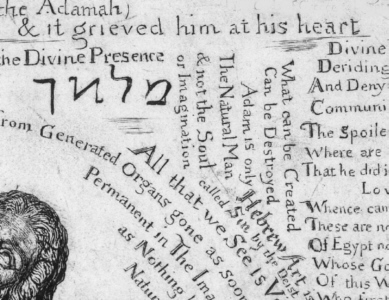William Blake's Laocoön: The Inscriptions
Part 5: Knock-On Effects
Extending the textual limits of this engraving, as outlined in Part 4 has knock-on effects.
For example, at the top of the engraving the addition of "Read Matthew C X. 9 & 10 v" in a smaller font allows Blake to fit in that addition without running past the right-hand textual border, and so the biblical reference must have been added after the "The Old & New Testaments [. . .]". (See figure 5a.)

Perhaps most noticeably, however, the extension of the border to the top and right decentres "He repented that he had made Adam / (of the Female, the Adamah)" and leaves an obvious gap to its right (see figure 5b).

The words "& it grieved him at his heart" seem to serve as a compositional corrective to this imbalance. In turn, that inscription feeds into the arrangement of many of the engravings in the top right-hand side of the plate.

An interesting example of this is found in the lines of poetry appearing together under the words "Divine Union [. . .]" (figure 5d). Had Blake known from the outset that he was going to engrave all of the lines we now see, he would surely have set the whole block further to the right, to run in a straight line. Instead, the bottom lines have to swerve to avoid "Hebrew Art is".
The top lines of the block ("Divine Union [. . .]") follow a similar curvebut for a different reason. They are stepped backwards not in order to avoid the roughly engraved horizontal shading (which I shall show came later), but so that they mirror the indentations of the lines around "Hebrew Art " and still flow into "The Spoilers say [. . .]".
"The Spoilers say / Where are his Works / That he did in the wilderness" must, by this analysis, have been the first lines of this block of poetry that Blake engraved and those above and below them thoughts added subsequently.
The next block to have been added to this upper-right section of the engraving must have been the lines that run from "Lo what are these" down to "Imaginative Art", since they dictate the length of the line "The whole Busineſs of Man Is" and cause "The Arts" to be placed on a separate line (which makes no sense in terms of the meaning).
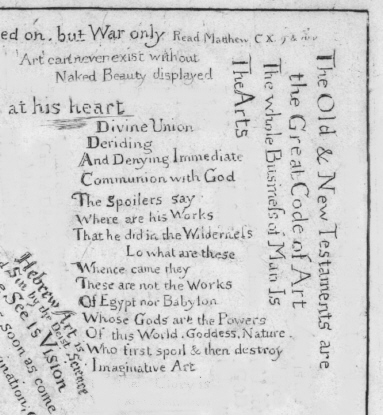
Spaces created by the emerging arrangement were evidently regarded by Blake as gaps. "The whole Busineſs of Man Is / The Arts" was probably engraved shortly after "The Spoilers say [. . .]", with "Art can never exist without / Naked Beauty displayed" following on from that to fill one of those gaps. The gap between "Where any view of Money exists [. . .]" and "He repented that he had made Adam" was filled by the words "by pretences to the Two Impossibilities Chastity & Abstinence Gods of the Heathen": this must have been added after "Art can never exist without / Naked Beauty displayed", as it sits off-centre and is out of line even with the line to which it forms an extension, "Where any view of Money exists Art cannot be carried on. But War only Read Matthew C X. 9 & 10 v". (See figure 5e.)
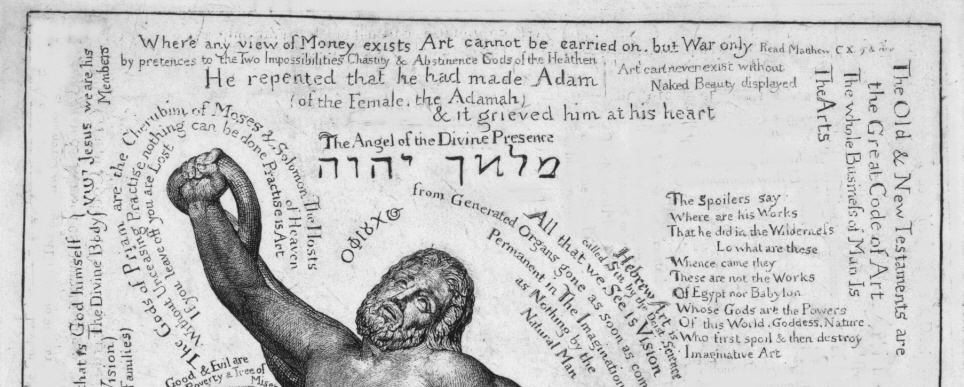
"Divine Union [. . .]" evidently appeared after The whole Busineſs of Man Is / The Arts" as the third and fourth lines of this block extend out into the area left vacant after "The Arts". Because Blake had stepped these lines backwards, a triangular space remained to their left. It seems likely that his solution was the rough horizontal hatching beneath the end words of "& it grieved him at his heart". The similar lines to the left of that phrase—between "(of the Female, the Adamah)" and "The Angel of the Divine Presence"—may well have been added at the same point, in part to balance the lines to the right, but also to fill up another empty area.
The lines "Empire against Art See Virgils Eneid. / Lib. VI. v 848" were probably incorporated into the engraving prior to "Art is the / Tree / of Life, which fits into the space between them, "the Great Code of Art", and "Who first spoil & then destroy / Imaginative Art". (See figure 5f.)
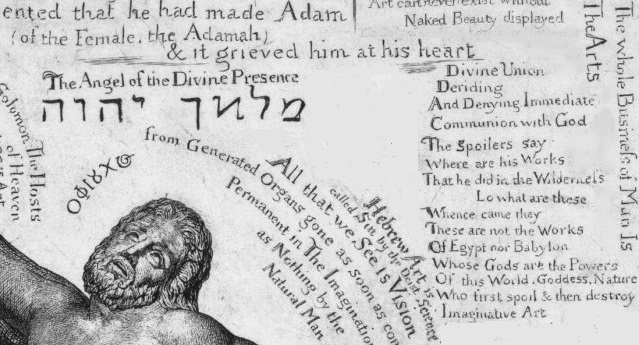
It is unlikely that the instription "For their Glory is / War and Dominion" originally followed "Imaginative Art". Its positioning and length makes little sense unless it was produced after "Artis the / Tree / of Life and God / is Jesus: its arrangement appears to be contingent upon the space available. The words "GOD / is Jesus" may have been added later still, as it too seems to be fitted into, rather than to command, the space in whch it appears. (See figure 5g.)
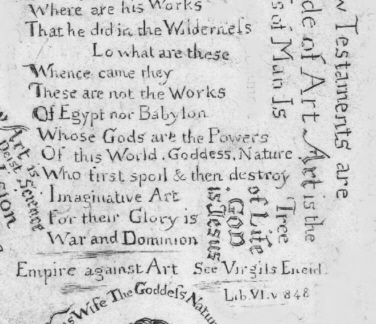
The inscription "What can be Created / Can be Destroyed" must have been added at some point after the addition of the scratched lines beneath "his heart", which they appear beneath. The statement "Adam is only / The Natural Man / & not the Soul / or Imagination" was probably inserted not long afterwards, as it fills the remaining space in this area. This statement could be positioned further towards the line "& it grieved him at his heart" as there were no hatched lines to avoid there. (See figure 5h.)
